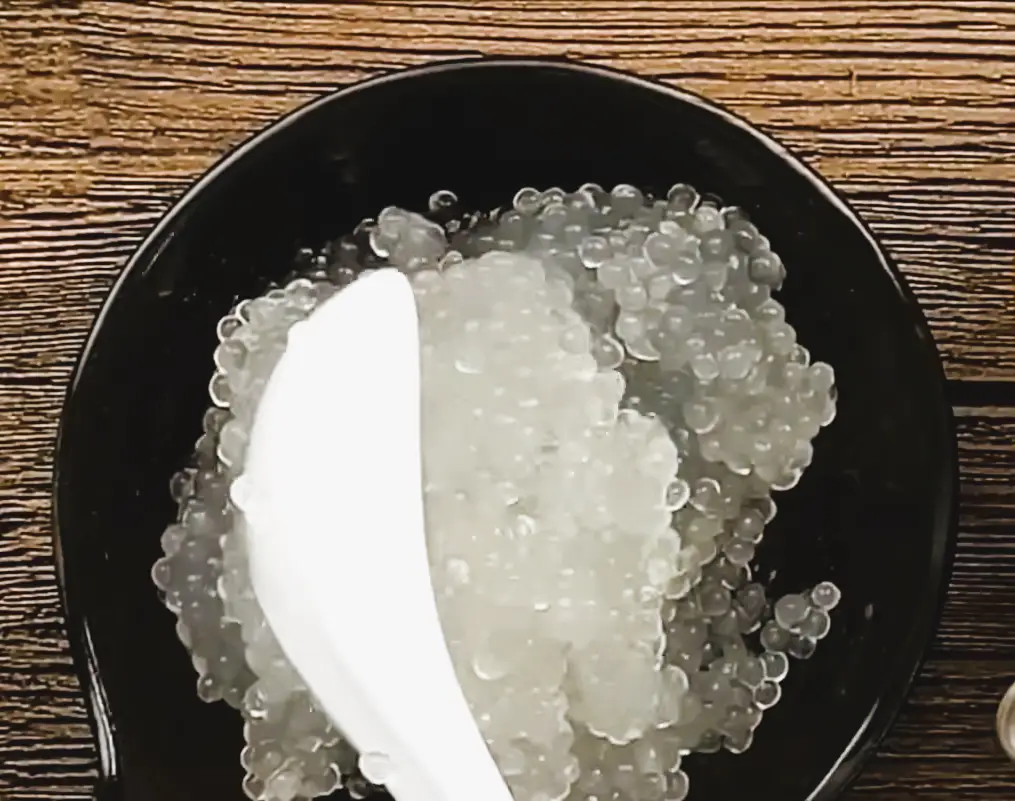I. Introduction
In the culinary realm, tapioca and sago often find themselves in the same pot, so to speak. But are they truly identical twins or more like distant cousins? Let’s peel back the layers to discern the nuances. Tapioca and sago, while sharing some similarities, boast distinct characteristics that set them apart.
A. Definition of Tapioca and Sago
First things first, what exactly are tapioca and sago? Tapioca, derived from the cassava plant, presents itself as small, chewy pearls commonly used in puddings and bubble teas. On the other hand, sago originates from the pith of tropical palm trees, offering translucent, gelatinous orbs used in various culinary delights.
B. Importance of Understanding the Differences
Why bother discerning between these seemingly similar starches? Well, my friend, knowing the disparities between tapioca and sago can elevate your culinary prowess to new heights. Whether you’re whipping up a dessert or experimenting with savory dishes, understanding their unique qualities ensures you wield the right ingredient for the job. So, let’s embark on this enlightening journey to unravel the mystery of tapioca and sago.
II. Origins and Cultivation
A. Tapioca: Origin and Cultivation
Let’s dive into the roots of tapioca. Originating from the cassava plant (Manihot esculenta), tapioca traces its lineage back to the lush lands of South America, where indigenous communities cultivated this starchy tuber for centuries. The cassava plant thrives in tropical climates, with countries like Brazil, Nigeria, Thailand, and Indonesia leading the charge in its cultivation. This hardy plant withstands adverse conditions, making it a resilient staple in many cultures.
B. Sago: Origin and Cultivation
Now, let’s uncover the origins of sago. Unlike its cassava counterpart, sago emerges from the heart of palm trees, predominantly the sago palm (Metroxylon sagu). Indigenous to Southeast Asia, particularly regions like Malaysia, Indonesia, and Papua New Guinea, the sago palm has been a vital source of sustenance for communities inhabiting these tropical locales. Harvesting sago involves extracting the starch-rich pith from the trunk of mature sago palms, a labor-intensive process deeply ingrained in the traditions of these regions.

III. Botanical Differences
A. Tapioca Plant
Let’s delve into the botanical realm to uncover the distinctive features of the tapioca plant. The cassava plant, also known as manioc or yuca, boasts a robust stature with thick, tuberous roots that store the precious starch we know as tapioca. Scientifically labeled Manihot esculenta, this perennial shrub belongs to the spurge family (Euphorbiaceae) and thrives in warm, tropical climates. With its lance-shaped leaves and delicate white or pink flowers, the cassava plant offers more than just tapioca; it’s a versatile crop deeply entrenched in agricultural practices worldwide.
B. Sago Palm
Now, let’s turn our attention to the majestic sago palm. Unlike the cassava plant, which yields tapioca from its roots, the sago palm (Metroxylon sagu) produces sago within its trunk. This towering palm species, native to Southeast Asia and the Pacific Islands, boasts a striking appearance with its feather-like fronds and towering stature. Sago production involves extracting the starchy pith from the trunk, a process that requires patience and skill. While the sago palm may not offer the same culinary versatility as the cassava plant, its unique characteristics make it a valuable resource in regions where it thrives.
IV. Processing Methods
A. Tapioca Processing
Let’s explore the journey from cassava root to tapioca pearls. Tapioca processing begins with harvesting mature cassava roots, which are then thoroughly washed and peeled to remove any dirt or impurities. Next, the roots undergo grating or shredding to break them down into a fine pulp. This pulp is then subjected to a pressing or squeezing process to extract the starchy liquid. Through a series of filtration and settling stages, the starch settles at the bottom, forming a sediment. The sediment is then dried and pulverized into a fine powder, creating the tapioca flour commonly used in baking and cooking. To form the iconic pearls, tapioca flour is mixed with water to create a dough, which is then rolled into small spheres and either dried or cooked to achieve the desired texture.
B. Sago Processing
Now, let’s unravel the intricacies of sago processing. The journey begins with the harvesting of mature sago palm trunks, which are felled and split open to access the starchy pith within. This pith is extracted and crushed to release the starch, which is then thoroughly washed to remove impurities. The washed starch undergoes a sedimentation process, where it settles at the bottom of containers. Once settled, the starch is collected, dried, and sieved to obtain the desired sago granule size. Depending on the intended use, sago granules may undergo further processing, such as roasting or toasting, to enhance flavor and texture. The result is the translucent, pearl-like sago pearls ready to elevate a variety of dishes.
V. Culinary Uses
A. Tapioca in Cooking
Tapioca lends its unique texture and versatility to a myriad of culinary creations. From delectable desserts to hearty soups, tapioca proves its worth in the kitchen. One of its most iconic applications is in tapioca pudding, a creamy delight made by simmering tapioca pearls in milk or coconut milk until they become translucent and gelatinous. Tapioca flour, with its binding properties, also serves as a gluten-free alternative in baking, adding moisture and structure to various recipes like bread, cakes, and cookies. Moreover, tapioca pearls find their way into refreshing bubble teas, where they add a chewy, fun element to the beverage.
B. Sago in Cooking
On the other hand, sago takes center stage in a different array of culinary delights. This translucent starch shines in desserts like sago pudding, where it’s boiled with coconut milk and sugar to create a creamy, indulgent treat. Sago also finds its way into savory dishes, thickening soups and gravies to achieve a velvety consistency. In some cultures, sago is even fashioned into savory cakes or fritters, showcasing its adaptability in various culinary traditions. Whether sweet or savory, sago adds a unique texture and mouthfeel to dishes, making it a beloved ingredient in many cuisines.
VI. Nutritional Comparison
A. Nutritional Profile of Tapioca
Tapioca offers more than just its delightful texture; it also brings a nutritional punch to the table. Rich in carbohydrates, tapioca serves as a significant energy source, making it a staple in many diets. However, it’s relatively low in protein and lacks significant amounts of vitamins and minerals. While it’s naturally gluten-free, tapioca does not provide much fiber, which is essential for digestive health. Nevertheless, when consumed in moderation as part of a balanced diet, tapioca can be a tasty addition to your culinary repertoire.
B. Nutritional Profile of Sago
Similarly, sago boasts a carbohydrate-rich profile, offering a quick source of energy. However, like tapioca, sago is also deficient in protein and lacks essential vitamins and minerals. Additionally, sago contains minimal fiber, which may impact digestive health if consumed in large quantities. Despite these limitations, sago remains a popular ingredient in many cuisines, valued for its unique texture and culinary versatility. As with tapioca, moderation is key when incorporating sago into your diet to ensure a well-rounded nutritional intake.

VII. Culinary Properties
A. Texture and Consistency of Tapioca
When it comes to texture and consistency, tapioca stands out with its distinctive chewiness. Tapioca pearls, whether small or large, have a resilient, gel-like texture when cooked, giving dishes a delightful mouthfeel. This unique texture adds an element of fun and surprise to desserts and beverages, creating an enjoyable sensory experience for the palate. Additionally, tapioca flour contributes to the light and airy texture of baked goods, producing tender and moist results that are hard to resist.
B. Texture and Consistency of Sago
Conversely, sago offers a different texture and consistency that sets it apart in the culinary world. Sago pearls, when cooked, become translucent and soft, with a slightly gelatinous texture that melts in the mouth. Unlike the chewiness of tapioca, sago pearls have a smoother, more delicate feel, making them ideal for creamy desserts and thickening soups and sauces. This unique texture adds a luxurious touch to dishes, elevating them to new heights of indulgence and satisfaction.
VIII. Culinary Applications
A. Tapioca in Desserts
Tapioca pearls find a sweet spot in the world of desserts, adding both texture and flavor to a variety of sweet treats. One of the most beloved desserts featuring tapioca is tapioca pudding, a creamy concoction made by simmering tapioca pearls in milk or coconut milk until they become soft and translucent. This pudding can be flavored with vanilla, coconut, or other extracts to suit different tastes. Tapioca pearls also make appearances in bubble teas, where they add a fun, chewy element to the beverage. Additionally, tapioca flour serves as a gluten-free alternative in desserts like cakes, cookies, and puddings, providing a light and tender crumb.
B. Sago in Desserts
Sago takes its rightful place in the dessert realm, starring in a variety of sweet indulgences across different cultures. is a creamy delight made by boiling sago pearls with coconut milk and sugar, showcases the pearl’s unique texture and delicate flavor. This pudding can be enjoyed warm or chilled, topped with fruits or flavored syrups for added sweetness. In addition to pudding, sago is also used in traditional Asian desserts like sago cakes and sago coconut milk soup, where its soft, gelatinous texture adds a luxurious touch to the dish. With its versatility and delicate flavor, sago continues to captivate dessert lovers around the world.
IX. Regional Variations and Preferences
A. Tapioca in Different Cuisines
Tapioca transcends borders, making its mark in various cuisines around the globe. In Southeast Asia, tapioca pearls are a staple in desserts like sago gula melaka, a sweet concoction of tapioca pearls drizzled with palm sugar syrup and coconut milk. That’s fascinating! It’s incredible how tapioca flour is utilized in such diverse culinary traditions. In Brazil, tapioca crepes offer a versatile canvas for both sweet and savory creations, while in South India, dishes like kappa biryani showcase the rich flavors of tapioca in savory curries. It’s a testament to the adaptability and deliciousness of this ingredient across cultures. Each cuisine infuses its unique flavors and techniques into tapioca dishes, showcasing the versatility of this humble ingredient.
B. Sago in Different Cuisines
Similarly, sago finds its place in diverse culinary traditions, each with its own unique preparation methods and flavor profiles. In Malaysia and Indonesia, sago pearls are commonly used in desserts like sago gula Melaka, a decadent dessert made with sago pearls, palm sugar syrup, and coconut milk. In Papua New Guinea, sago is a dietary staple, often served as a porridge or cooked into savory dishes like sago pancakes or fritters. Additionally, in parts of Southeast Asia, sago is used in traditional drinks like sago water, a refreshing beverage made by soaking sago pearls in water with a hint of pandan or rose flavoring. Across different cuisines, sago lends its unique texture and versatility to a wide range of dishes, showcasing its adaptability in various culinary contexts.
X. Health Considerations
A. Health Benefits of Tapioca
Despite its primarily carbohydrate-based composition, tapioca offers some health benefits worth noting. Firstly, it’s naturally gluten-free, making it a suitable option for individuals with gluten sensitivities or celiac disease. Additionally, tapioca is low in sodium and cholesterol, making it a heart-healthy choice when consumed in moderation. Furthermore, tapioca contains small amounts of essential minerals like calcium and iron, which contribute to overall bone health and oxygen transport in the body. However, it’s essential to consume tapioca in moderation due to its high carbohydrate content, which can impact blood sugar levels, especially for individuals with diabetes.
B. Health Benefits of Sago
Similarly, sago offers some health benefits despite its carbohydrate-rich nature. Like tapioca, sago is also gluten-free, making it suitable for those with gluten sensitivities. Additionally, sago provides a quick source of energy, making it ideal for replenishing glycogen stores after intense physical activity. Furthermore, sago contains small amounts of minerals like calcium, iron, and potassium, which play essential roles in bone health, oxygen transport, and electrolyte balance. However, similar to tapioca, it’s crucial to consume sago in moderation due to its high carbohydrate content, which can impact blood sugar levels and contribute to weight gain if overconsumed.
XI. Allergies and Intolerances
A. Tapioca Allergies and Intolerances
Generally, most individuals tolerate tapioca well, but allergic reactions or intolerances can occur, albeit rarely. Allergic reactions to tapioca are typically associated with sensitivities to other plants in the same family, such as latex or cassava. Symptoms of a tapioca allergy may include itching, swelling, hives, or difficulty breathing. Additionally, some individuals may experience digestive discomfort or bloating after consuming tapioca, particularly if they have sensitivities to high-fiber foods or specific carbohydrates like resistant starch.
B. Sago Allergies and Intolerances
Similarly, allergic reactions to sago are uncommon but can occur in individuals with sensitivities to palm products or starches. Symptoms of a sago allergy may resemble those of other food allergies and can include itching, swelling, rash, or difficulty breathing. Additionally, some individuals may experience digestive issues like bloating, gas, or abdominal discomfort after consuming sago, particularly if they have sensitivities to high-carbohydrate foods or specific starches.
It’s essential for individuals with known allergies or intolerances to tapioca or sago to read food labels carefully and avoid products containing these ingredients to prevent adverse reactions. If you suspect an allergy or intolerance, consult with a healthcare professional for proper diagnosis and management.
XV. Conclusion
A. Summary of Key Differences
In conclusion, while tapioca and sago may appear similar at first glance, they possess distinct characteristics that set them apart. Tapioca, derived from the cassava plant, offers chewy pearls and versatile flour, primarily used in desserts and baking. On the other hand, sago, originating from the sago palm, presents translucent pearls with a softer texture, commonly featured in sweet and savory dishes across various cuisines. Additionally, their nutritional profiles, culinary properties, and environmental impacts differ, highlighting the importance of understanding these nuances.
B. Importance of Understanding the Distinctions
Understanding the differences between tapioca and sago is crucial for culinary enthusiasts, chefs, and consumers alike. By discerning their unique characteristics, individuals can make informed choices when selecting ingredients for recipes, ensuring optimal flavor, texture, and nutritional balance. Moreover, appreciating the cultural and environmental contexts of tapioca and sago production fosters a deeper connection to the foods we enjoy and promotes sustainability in agricultural practices. Overall, by recognizing and respecting the distinctions between tapioca and sago, we enrich our culinary experiences and contribute to a more vibrant and sustainable food system.
FAQs
- Question: What is the difference between tapioca and sago?
Answer: Tapioca and sago are both starch extracts, but tapioca is derived from the cassava root, while sago comes from the pith of the sago palm. - Question: Are tapioca and sago the same thing?
Answer: While both are starch extracts, tapioca and sago come from different plants, cassava for tapioca and the sago palm for sago, making them distinct ingredients. - Question: What are the health benefits of tapioca and sago?
Answer: Both tapioca and sago are gluten-free and low in protein and fat, making them suitable options for those with dietary restrictions. They also provide carbohydrates for energy. - Question: How are tapioca and sago used in cooking?
Answer: Tapioca and sago are commonly used in desserts, puddings, and bubble teas as thickeners or as main ingredients. They absorb flavors well and add a unique texture to dishes. - Question: What are the environmental considerations of tapioca and sago production?
Answer: Tapioca production from cassava can have environmental impacts due to deforestation for cultivation. Sago production, on the other hand, is more sustainable as it comes from the sago palm, which grows naturally in tropical forests. However, unsustainable harvesting practices can still pose threats to local ecosystems.

